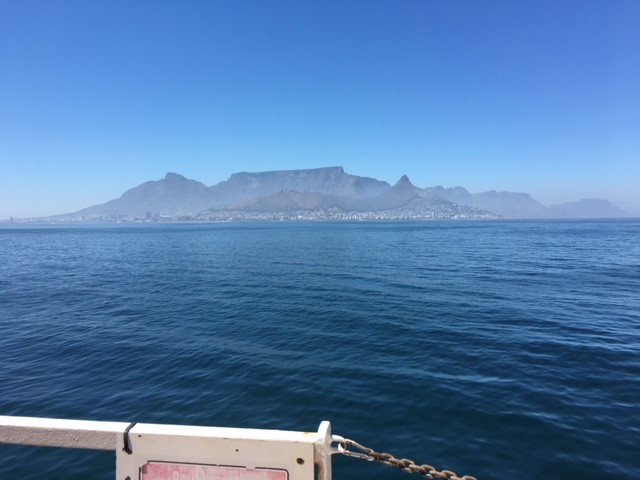There is reason to believe that gyres are "leaky" and may present a source of MP beyond the five gyres proper, and South America is thought to be the major source of plastic marine debris for the SASG based on both empirical and modelling methods. This cruise aims to evaluate the sources of MP in the South Atlantic Subtropical Gyre (SASG). These comparisons will be based on: (a) characterization of MP properties, such as particle morphology, polymer composition, extent of degradation, and (b) analysis of persistent organic pollutants (POPs) loads, and (c) examination of the microbial communities of the MP (Plastisphere).
Our research plan is collect samples of plastic marine debris, phytoplankton, and other particles and to compare net-collected versus instrument-measured concentrations, including camera and visual surveys. Using established as well as some new equipment and alternative methods, we will attempt to measure microplastics concentrations below the surface, and those that are too small for traditional net sampling. Periodic samples will be preserved for DNA extraction and advanced imaging (SEM, LSM) to investigate the microbial community in the seawater, as well as that attached to plastic and other substrates encountered, and ship-board experiments will be conducted to study the colonization rates of plastic immersed in seawater. Water, filtered, and macro pieces of plastic, as well as biomass samples will be processed and preserved for analysis of Persistent Organic Pollutants (POPs) back in the laboratory.
We hope you'll enjoy reading our blog!
January 23rd | On the look-out for macroplastics
Although plastics are known for their durability, once remaining in the ocean, they will slowly deteriorate due to environmental forcing, abrasion, marine life and weathering. Large, intact objects will slowly break down into tiny pieces. Therefore, research classifies ocean plastic in several size classes. When measured by count, the small size classes are more abundant, while the largest part of the weight is present in the large size classes.
It is a challenge to get a scientific measure of the presence of large size plastics (let’s say >5cm) within the gyre. Small size particles are generally more evenly distributed throughout the gyre, while the occurrence of large size plastics is more ‘event’-like. To record enough occurrences of large size classes, a large area should be sampled. One method used to measure the presence of large size plastics is by visual surveys. The method employed is similar to that of a marine mammal observer looking for marine mammals. During a dedicated time period ‘marine plastic observers’, standing on the bridge deck, scan the ocean in search of plastics. During our expedition we’re taking turns in performing the 1-hour watches. On top of the bridge deck with a beautiful view over the ocean and accompanied by good weather, the visual surveys have proven to be very popular! The results from the observation watch were as expected. As we were approaching the patch center, the number of visual records gradually increased.
Next to visual observing, we’re working on the development of remote sensing techniques. The idea is that by scanning a large surface area and employing image processing, it is possible to measure the presence of large size plastic objects. Currently we’re experimenting with two types of set-ups.
The first set-up involves a camera that scans the surface area near the ship from a bridge deck perspective. When everything is set-up, this method doesn’t involve a lot of human intervention and can thus be used to sample a large area consecutively. If this method proves to be fruitful, in the future, cameras could be added to ships to scan the trajectory they’re sailing for plastics. The second technique involves a drone that scans the water surface from a birds-eye perspective. The drone does involve human oversight, as it needs to be controlled, but it is not tied to the ship’s location. This makes it possible to securely scan a square grid. Image processing is done back home so unfortunately there are no results from these experiments yet! I did however have some time to shoot some scenic movies of the RV Pelagia.
Hans Limburg - computational modeler working with Matthias Egger, a biogeochemist with The Ocean Cleanup
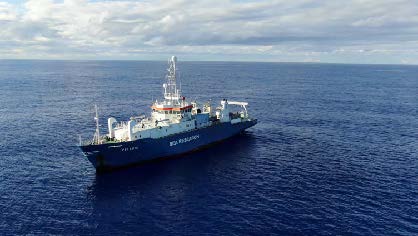
January 18th | In search of the missing plastic
I am joining the RV Pelagia-448 cruise from Dr. Tracy Mincer’s lab, Harbor Branch Oceanographic Institution (HBOI), Florida Atlantic University (FAU), in Fort Pierce, Florida, USA. One of my research interests is the mystery of missing plastics. Standing stocks of surface oceanic plastic waste account for less than 1% of the plastic waste input (4.8-12.7 million tons from terrestrial sources in 2010). Furthermore, a tremendous loss of microplastics smaller than 1 mm was observed at the sea surface. These data suggest the upper ocean is not the ultimate sink for plastic debris and bring the ultimate fate of microplastics into question. The deep ocean may be one of the sinks for these disappearing microplastics.
During this cruise, we are using McLane WTS-LV pumps to collect water samples with stacked filters (200 µm, 40 µm and 2 µm) and looking for the vertical distribution of oceanic microplastics. These McLane pumps are deployed at four depths at one time and filter in-situ seawater up to 5 hours. Post sample collection, microplastic analysis by spectrometers and SEM will be conduct in our lab at HOBI and at NIOZ. Artificial contamination is a serious problem when you are looking for smaller microplastics. Because plastics are so commonly used, scientific samples may be contaminated by the scientists themselves, crewmembers and scientific instruments. Luckily, we have a brand-new PCR laminar flow hood in a great Clean Lab on board that can help us to minimize the potential contamination and ensure the quality of our samples. Hopefully, our efforts will provide clues to the fate of microplastics in the ocean’s water column.
Shiye Zhao - HBOI, FAU, Fort Pierce, Florida, USA
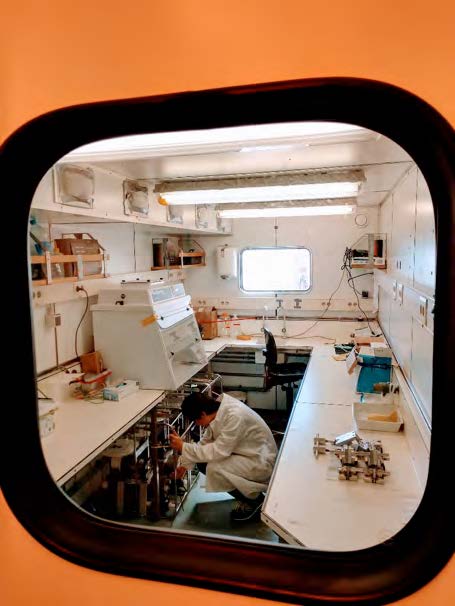
January 16th | Nanoplastics
Since I started my studies at Utrecht University, I’ve been interested in using chemistry for a more sustainable future. I finished my PhD in the field of catalysis on the topic of the reduction of nitrogen oxide, which is one of the most prominent air pollutants. Currently I am working at Utrecht University as a research technician for the Advanced Research Center Chemical Building Blocks Consortium (ARC CBBC). ARC CBBC addresses some of the major societal challenges related to chemistry and energy. We want to provide sustainable molecules and functional materials for the future. Our research issues are associated with the growing demand for the finite supply of raw materials and the ever-increasing demand for new material functionality. Such complex topics require input from different disciplines, and therefore scientific cooperation with other fields is highly needed. This holds also for the topic of sustainable plastics production, their use, and potential recycling.
Aboard the RV Pelagia I have been studying the smallest pieces of plastics, the so-called nanoplastics (5-500 nanometers) that are invisible even to traditional microscopes. We are currently “looking” at plastics pieces in the size range of 5-500 nanometers. To give you an idea about how small this actually is; a single strand of human hair is about 80 000 to 100 000 nanometers thick! At the moment, there are many questions surrounding these nanoplastics, but it is already known that the smallest of them can go through cell membranes of humans and other living organisms. Since these plastics could contain toxins, heavy metals and unwanted bacteria, this means the smallest nanoplastics could bring these substances straight into our living cells. Effects on human health, if at all present, are however unknown as well as many other topics related to nanoplastics.
Analyzing these nanoplastics requires very specialized equipment. So aboard the Pelagia I am concentrating seawater from liters down to a few milliliters, collected from different depths and locations around the subtropical south Atlantic Ocean to bring back to our labs where we have the right kind of equipment to study these particles. Once back at home, we will analyze these samples and determine what kinds of plastics, what size, and which concentration of plastics are found in the collected water. Since other research aboard the vessel focusses on microplastics, macroplastics, and persistent organic pollutants, the whole spectrum of size ranges is covered by this research cruise.
Ramon Oord - ARC CBBC, Utrecht University
January 15th | Out of the blue
While both the media and scientific communities have given a lot of attention to microplastics, we should not forget that most of these small pieces originally come from large objects. So-called macroplastics can remain at sea for years, with small fragments continuously breaking off over time. In order to study these we have been collecting pieces of macroplastic as we spot them from the bridge and retrieve them with a net. However, there is currently no way to tell how long an object has been at sea, not unless one is extremely lucky. Fortunately, on the 15th we were!
Scientists have been releasing buoys with GPS and various other sensors into the ocean for over 20 years and those have been vital in improving our understanding of the ocean currents. The drifters are battery powered, and so they only transmit data for around 2 years, although afterwards they remain floating at sea. On the 15th we found one of these drifters, and although its label had fallen off, the drifter number 39257 remained scratched into the drifter surface. After a quick database search by colleague Doug Wilson on land, we had the trajectory of our buoy, showing it had been released almost 15 years earlier off the coast of Argentina.
This is significant in various ways. Firstly, if we compare the position of the buoys' last transmission with where we retrieved it 14 years later (orange star), we can see that the two are not very far apart. Of course, we don’t know exactly what path it took while it was not transmitting, so once I’m back on land it will be fun to simulate its possible path with ocean current data. Furthermore, it shows that macroplastic can remain at sea for decades and based on the state the drifter was in, it could easily have remained afloat for another couple of decades at least. It is thus yet another example of how long plastic pollution persists in the ocean, and action must be taken to mitigate it.
Victor Onink - PhD candidate in the Laufkötter Research Group at the University of Bern, Switzerland

January 9th | MantaRays and Manta Trawls
I am joining Pelagia cruise 448 from the Field Robotics Laboratory at Northeastern University in Boston, USA. My research aims to simplify and better standardize the process of sampling microplastics in the ocean using new technologies. During this cruise, I will be further testing an instrument called the MantaRay, which uses a flow through system, particle imaging, and spectroscopy to identify microplastics in mixed particle samples.
I will be collecting surface samples throughout our cruise and correlating the data produced by MantaRay to our standard microplastic collection and processing techniques. In addition to testing MantaRay, I will be collecting filtered samples from the RV Pelagia’s flow through seawater system and CTD hydrocast to test the feasibility of sampling and automatically scanning microplastics on filters using FTIR spectroscopy and microscopy back at our lab in Boston.
Of particular interest to me is the settling of microplastics at the pycnocline, an oceanographic feature that may potentially act as a temporary barrier to microplastics as they become negatively buoyant and move into the deep sea. I am happy to be joining this cruise and am looking forward to seeing how all of the data comes together in this extensive sampling effort!
Ethan Edson - Northeastern University, Boston, Ma, USA
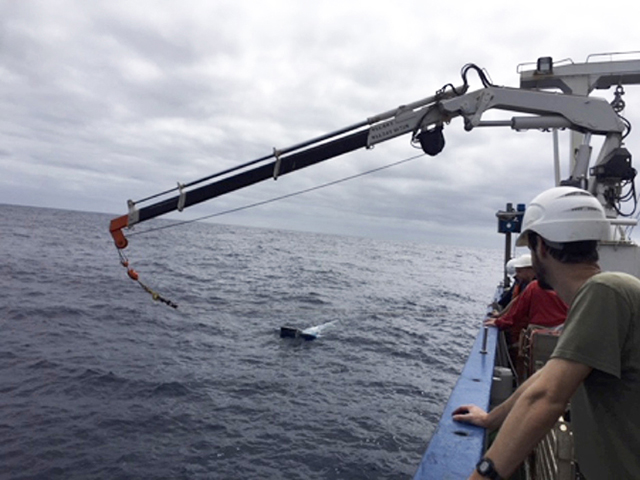
January 8th | The Super Station, CAPE Basin, South Atlantic
The Pelagia crew and scientists began our first “Super Station” just after lunch with a Manta Net Trawl towing for 30 minutes to sample plastic floating at the surface of the ocean. As soon as the Manta Trawl came on deck, one group started processing that sample while another team deployed the Hydro-Bios MultiNet, a device with 5 individual nets that can be opened remotely, allowing us to sample for plastic at 5 different depths. Nets were towed for 30 minutes each and closed at 100, 80, 60, 40, and 20 m, so the entire operation required about 3 hours. When it came up each net was processed quickly to look for plastic and to quantify the plankton.
After the MultiNet, the Pelagia stopped and we lowered the CTD with sampling bottles to within 7m of the bottom, 5300m below us! The CTD measures salinity, temperature, oxygen, light, pressure, and several other things as we lower it, and allows us to collect water from specific depths that have characteristics of interest to us, such as higher concentrations of plankton and other particles. Once the CTD came back on deck there was a flurry of activity with multiple people sampling all the water bottles for different analyses (DNA, nutrients, pigments, plastic) in a specific order.
As soon as sampling from the water bottles was done, we put the wire back in the water and started attaching our four McLane WTS systems. These are underwater pumps that allow us to filter large volumes (2000L) of water at different depths through a series of meshes and filters to trap the very small pieces of plastic that occur all the way to the bottom of the ocean. The WTS pumps were lowered to the appropriate depths and left there for 6 hours to pump water before recovery.
Finally, we lowered the big box-corer to sample the sediment on the very bottom that will be processed for plastic back at NIOZ. When the sediment came up we were excited to see polymetallic nodules on the surface; these are precipitate/concretions with high concentrations of metals that form on the bottom in specific areas of the deep sea.
Overall, the entire operation took almost 24 hours, so everybody aboard is tired but we are very satisfied with our collection of plastic for analysis in all size categories from the surface all the way to the bottom. This represents a very complete data set for plastic at one location in an area of the world ocean that is not well sampled.
Erik Zettler - visiting scientist NIOZ
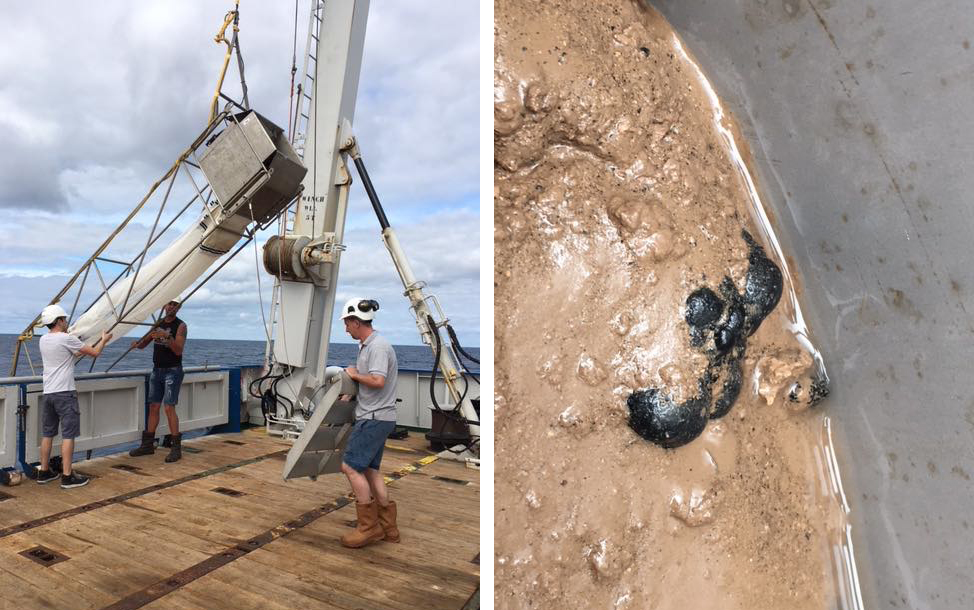
January 7th | Go west, young men
The past four days, we’ve been heading West from Cape Town towards the “South Atlantic garbage patch”. But what is such a garbage patch? In subtropical regions on both sides of the Equator, the prevailing trade winds tend to push surface water towards the poles. Meanwhile at higher latitudes, the easterly winds blow in the opposite direction and push the water towards the Equator, forming a slowly circulating current, known as a gyre. Gyre systems accumulate all kinds of marine debris towards their center, forming a so-called garbage patch.
Now, the valid question could be raised: How can we find this South Atlantic garbage patch? Next to the scientists that collect samples and perform experiments, expedition PE448 is also accompanied by three numerical modelers: Philippe, Victor and Hans. They all work on simulating plastic transport through our oceans and understanding the dynamics of garbage patches:
Philippe Delandmeter: I’ve been working as a Postdoctoral Scientist in Utrecht University for over a year. With Erik van Sebille, I developed the Parcels framework that can be used to simulate the transport of particles in the ocean. Particles can represent plankton, kelp, fish, etc., and of course plastic! Using Parcels, we aim to create a 3D map of the plastic litter polluting our oceans.
Hans Limburg: As a master student I’ve performed my graduation work at The Ocean Cleanup. Upon graduation I’ve stayed with The Ocean Cleanup as a computational modeler. In this role I participate in the research of 3D global particle dispersion, plastic dispersion forecasting of the Great Pacific Garbage Patch and micro-scale plastic capturing efficiency studies of our systems.
Victor Onink: I am a PhD student from the University of Bern, where I work on modeling the fate of microplastics in the oceans and its effects on marine ecosystems with Dr Charlotte Laufkötter. I have been looking to model how microplastics break down into progressively smaller pieces, while for my master thesis I studied the physical mechanisms that drive the formation of the garbage patches in the subtropical ocean gyres with Dr Erik van Sebille.
We ran various simulations based on our distinctive models, showing the South Atlantic garbage patch mean location in January, as well as in the past few months. The results agree with previous modeling studies: we expect to start finding higher plastic concentrations when we’ll pass the Greenwich Meridian, around 30°S. So now, the order is: Go West!
Hans Limburg, Victor Onink & Philippe Delandmeter
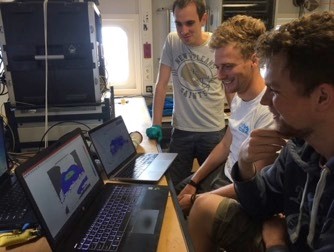
January 6th | In search of eDNA
I’m joining the RV Pelagia cruise from the Centre for Environmental Genomics Applications (CEGA) in St. John’s, Newfoundland, Canada and the Hajibabaei Laboratory. We use DNA from the environment to characterize the biodiversity of ecosystems. All organisms shed some DNA as they pass through the environment, from tiny microbes to giant whales. By filtering water samples from the environment, we can collect this free DNA, and sequence it to identify what species the DNA comes from and therefore create a biodiversity inventory for the environment we sampled.
On this cruise, we are collecting water samples at multiple depths as we travel from South Africa and into the South Atlantic gyre, where plastics are known to accumulate. Using these samples, we will be able to characterize the marine diversity throughout the water column while simultaneously monitoring plastic presence and abundance. Additionally, we have two different filtration systems deployed: one to filter large water volumes (~300 L) and one to filter small volumes (~1 L) that will allow us to compare methodologies for environmental DNA analysis.
This is my first time joining a research cruise like this so my first few days onboard have been full of new experiences. I have figured out a routine for processing my samples, which definitely keeps me busy, but I have also been learning about all the other sampling efforts going on. And keeping an eye out for pelagic birds and marine mammals when I can!
It will be very exciting to bring our samples back on shore, process them in the lab and see all of the data the team generates and how it integrates with our biodiversity results!
Beverly McClenaghan - CEGA, St. John’s, Newfoundland, Canada
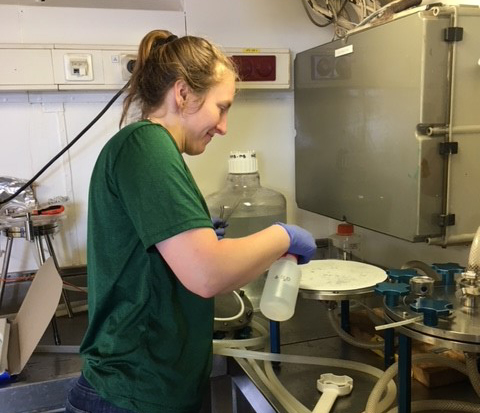
January 5th | Plastic POPs
I am an analytical chemist at the Swiss Federal Laboratories for Materials Science and Technology (Empa) in Dr. Norbert Heeb’s research unit. I am interested in persistent organic pollutants (POPs) that are toxic anthropogenic chemicals that do not degrade easily, bioaccumulate and are harmful to the environment. A good example is the once widely used insecticide DDT (Dichlordiphenyl-trichlorethan) that was officially classified as a POP under the United Nations Stockholm Convention and is now globally regulated. This case was very well described in Rachel Carson’s book “Silent spring” which inspired me to study the fate of chemicals.
During this research cruise, I am looking at POP levels in marine microplastics and their surrounding environment (water and sediments). Plastics can contain POPs added during manufacturing (e.g., as plasticizers or flame retardants) and can also absorb dissolved POPs directly from the environment. Therefore, microplastics can function as Trojan horses for POPs by increasing concentrations as they accumulate up the food chain. Upon my return to my home institution, I will extract the POPs and analyze them using gas/liquid chromatography coupled to mass spectrometry.
Highlights of the day
Overnight, several sediment-dwelling organisms became visible in the sediments recovered from our box core. I sampled two large worms (potentially polychaetes) and the box-core sediment they came from to compare their POP levels. I also collected and will analyze Velella velella from our manta trawl for POPs. Even though this jellyfish looks like a single organism, it is actually a colonial organism composed of tiny individual animals (zooid) of different functions.
Lena Schinkel - PhD Student Swiss Federal Laboratories for Materials Science and Technology
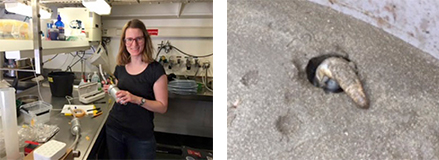
January 4th | Out of Africa
We left the port of Cape Town, South Africa today to start the South Atlantic Subtropical Gyre Cruise headed for the Atlantic Ocean's southern "Garbage Patch" to study plastic pollution. We are calling it the "Synergie" Cruise (Dutch for Synergy; German for SINERGIA) since it was inspired by interdisciplinary science that has brought together an amazing group of (mostly) young and talented scientists from many different backgrounds including chemistry, microbiology, genomics, physical oceanography, and engineering: you will learn about their interests and motivations during the course of the next three weeks. From nanoplastics to macroplastics, and the surface to 5,000 meters, we share the common goal of searching for the ocean's missing plastic! The first set of Manta trawls, Hydrocasts and Sediment box cores were done today and we, not surprisingly, recovered very little plastic in our Manta surface towing. Let's see what the future has in store for our efforts in the weeks ahead.
Gelukkig Nieuwjaar van de RV Pelagia!
Linda Amaral-Zettler - NIOZ Chief Scientist, 64PE448
